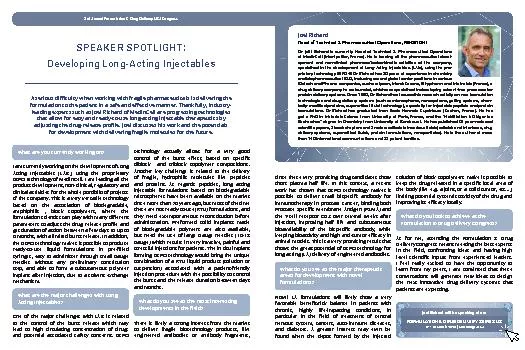

delivering the ng technologies rapeutics by the potentials e Dr Joël Richard is currently Head of Technical Pharmaceutical Operations at MedinCell Montpellier France He is leading all the ph ID: 826960
Download Pdf The PPT/PDF document "Developing Long-Acting Injectables" is the property of its rightful owner. Permission is granted to download and print the materials on this web site for personal, non-commercial use only, and to display it on your personal computer provided you do not modify the materials and that you retain all copyright notices contained in the materials. By downloading content from our website, you accept the terms of this agreement.
Developing Long-Acting Injectables deli
Developing Long-Acting Injectables delivering the ng technologies rapeutics by the potentials e. Dr Joël Richard is currently Head of Technical & Pharmaceutical Operations at MedinCell (Montpellier, France). He is leading all the pharmaceutical development and non-clinical pharmaco/toxico-kinetic activities of the company, specialized in the development of Long-Acting Injectables. (LAIs), using the proprietary technology BEPO®. Dr Richard has 30 years of experience in chemistry and biopharmaceutical R&D, including several global senior positions in various Biotech and Pharma companies, such as: Ipsen, Merck Serono, Ethypharm and Mainelab (France), a I am currently working on the development of Long Acting Injectables (LAIs), using the proprietary BEPO technology of MedinCell. I am leading all the product development, non-clinical, regulatory and clinical activities for the whole portfolio of projects of the company. This is a very versatile technology based on the association of biodegradable, amphiphilic , block copolymers, where the formulation scientist can play with many di�erent parameters to adjust the drug release pro�le and get duration of action between a few days to up to 6 months, with a limited burst release. In addition, the BEPO technology makes it possible to produce ready-to-use liquid formulations in pre-�lled syringes, easy to administer through small Gauge needles without any preliminary constitution step, and able to form a subcutaneous polymer implant after injection, due to a solvent exchange mechanism. What are the major challenges with Long technology actually allows for a very good control of the burst e�ect, based on speci�c diblock and triblock copolymer compositions. Another key challenge is related to the delivery of fragile, hydrophilic molecules like peptides and proteins. As regards peptides, long acting injectable formulations based on biodegradable microspheres have been available on the market since more than 20 years ago, but most of the time these are not ready-to-use (RTU) formulations, and they need extemporaneous reconstitution before administration. Preformed solid implants made of biodegradable polymers are also available, but need the use of large Gauge needles (16-18 Gauge) which results in very invasive, painful and stressful injections for patients. The in situ implant forming BEPO technology would bring the unique combination of a RTU liquid product (solution or suspension) associated with a patient-friendly since these very promising drug candidates show short plasma half life. In this context, a recent work has shown that BEPO technology makes it possible to deliver small bispeci�c antibody for immunotherapy in prostate cancer, binding both Prostate Speci�c Membrane Antigen (PSMA) and the T-cell receptor CD3 over several weeks after injection, improving half life and subcutaneous bioavailability of the bispeci�c antibody, while keeping bioactivity and high anti-tumor e�cacy in animal models. This is a very promising result that solution of block copolymers make it possible to keep the drug released in a speci�c local area of the body (like e.g. a joint, or a solid tumor, etc...), limiting potential systemic toxicity of the drug and What do you look to achieve at the FORMULATION & DRUG DELIVERY SERIES US